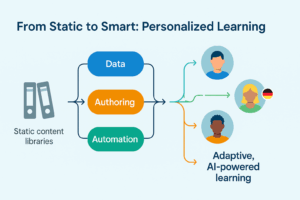By Gordon Johnson
The global pandemic led to a significant rise in the adoption of learning technologies. One area greatly impacted is educating customers and partners, which was traditionally conducted in-person or not at all.
Learning and Development (L&D) professionals who are experienced in online learning are well-positioned to digitally train customers and partners. However, supporting this type of external learning presents unique challenges.
In this article, we explore practical strategies to address these challenges, focusing on three key areas:
1. Educating Customers and Partners in a Complex Hierarchy
The external customer and partner landscapes can be complex, requiring sophisticated learning systems. Segmentation techniques that are used for internal employee training can also be applied externally, but in some cases, learners may need to be segregated based on each customer or brand.
This can involve providing each customer with a dedicated part of the learning system, effectively creating multiple autonomous instances or portals. Enabling customizations, such as different branding, business rules, notifications, languages, and security controls, allows tailored experiences for each customer or brand.
Delegating administration to customers, granting them specific permissions and roles, gives them the power to manage their own learning system.
2. Adapting Course Modality Rapidly
It’s no surprise that trainers who are accustomed to educating customers and partners in-person must adapt to online delivery. Migrating content from the classroom to virtual settings requires a thoughtful approach beyond mere substitution. However, L&D departments may lack the instructional design resources experienced with complex authoring tools.
To expedite the process, incorporating a simple authoring tool within the learning system enables subject matter experts (SMEs) to create online resources independently. Leveraging SMEs for content creation is a growing trend among L&D professionals.
3. Monetizing Customer Education
Unlike internal employee training, customer education often requires ecommerce capabilities. Yet, many learning systems lack native financial functionalities. As training moves online and scaling opportunities arise, automating financial transactions becomes crucial.
Integration with existing storefront products and payment gateways or employing learning systems with native and configurable financial options are viable solutions. Invoicing, receipts, multiple monetization strategies (subscriptions, coupons, certification licensing), and support for multiple currencies and taxation rules are essential features to consider.
Meeting Stakeholder Expectations
Internal L&D departments possess valuable experience that will help them support customer and partner education. However, ensuring your learning system aligns with external stakeholder expectations requires a thorough investigation.
Assess your existing internal learning system or LMS for hybrid capabilities that cater to both internal and external audiences. If it falls short, consider a specialized system that prioritizes the specific requirements of customer, partner, and other external training.
By addressing these practical considerations, organizations can optimize their learning systems for educating customers and partners in a rapidly evolving digital landscape.





















































